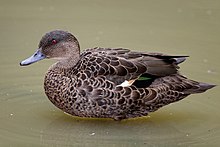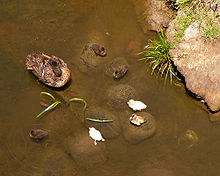Chestnut teal
| Chestnut teal | |
|---|---|

| |
| Male | |

| |
| Female | |
| Scientific classification | |
| Domain: | Eukaryota |
| Kingdom: | Animalia |
| Phylum: | Chordata |
| Class: | Aves |
| Order: | Anseriformes |
| Family: | Anatidae |
| Genus: | Anas |
| Species: | A. castanea
|
| Binomial name | |
| Anas castanea (Eyton, 1838)
| |
The chestnut teal (Anas castanea) is a dabbling duck found in Australia. It is protected under the National Parks and Wildlife Act 1974.[clarification needed]
Taxonomy[edit]
The chestnut teal was described by the English naturalist Thomas Campbell Eyton in 1838 under the binomial name Mareca castanea.[2] The specific epithet castanea is from the Latin castaneus for "chestnut-coloured" or "chestnut-brown".[3]
A large molecular phylogentic study that compared mitochondrial DNA sequences from ducks, geese and swans in the family Anatidae found that the chestnut teal is a sister species to the Sunda teal (Anas gibberifrons) that is endemic to Indonesia.[4]
Description[edit]
The chestnut teal is darker and a slightly bigger bird than the grey teal.[5]
The male has a distinctive green coloured head and mottled brown body. The female has a brown head and mottled brown body. The female is almost identical in appearance to the grey teal.
The female chestnut teal has a loud penetrating "laughing" quack repeated rapidly nine times or more.[5]
Distribution and habitat[edit]

The chestnut teal is commonly distributed in south-eastern and south-western Australia, while vagrants may occur elsewhere. Tasmania and southern Victoria are the species' stronghold,[5] while vagrants have been found as far north as New Guinea and Lord Howe Island, and as far south as New Zealand.[6]
The chestnut teal prefers coastal estuaries and wetlands, and is indifferent to salinity. This bird is an omnivore.
Breeding[edit]
Chestnut teals form monogamous pairs that stay together outside the breeding season, defend the nest site and look after the young when hatched. Nests are usually located over water, in a down-lined tree hollow about 6–10 m high. Sometimes nests are placed on the ground, among clumps of grass near water. The young hatch and are ready to swim and walk within a day.[6]
See also[edit]
References[edit]
- ^ BirdLife International (2016). "Anas castanea". IUCN Red List of Threatened Species. 2016: e.T22680277A92853345. doi:10.2305/IUCN.UK.2016-3.RLTS.T22680277A92853345.en. Retrieved 12 November 2021.
- ^ Eyton, Thomas Campbell (1838). A Monograph on the Anatidae, or Duck Tribe. London: Longman, Orme, Brown, Green, & Longman. p. 119.
- ^ Jobling, James A. (2010). The Helm Dictionary of Scientific Bird Names. London: Christopher Helm. p. 93. ISBN 978-1-4081-2501-4.
- ^ Gonzalez, J.; Düttmann, H.; Wink, M. (2009). "Phylogenetic relationships based on two mitochondrial genes and hybridization patterns in Anatidae". Journal of Zoology. 279 (3): 310–318. doi:10.1111/j.1469-7998.2009.00622.x.
- ^ a b c "Chestnut Teal". Victoria State Government: Game Management Authority. Archived from the original on 10 August 2017. Retrieved 9 August 2017.
- ^ a b "Chestnut Teal". Birds in Backyards. Archived from the original on 8 September 2012. Retrieved 27 January 2012.
External links[edit]
 Media related to Anas castanea at Wikimedia Commons
Media related to Anas castanea at Wikimedia Commons Data related to Anas castanea at Wikispecies
Data related to Anas castanea at Wikispecies

